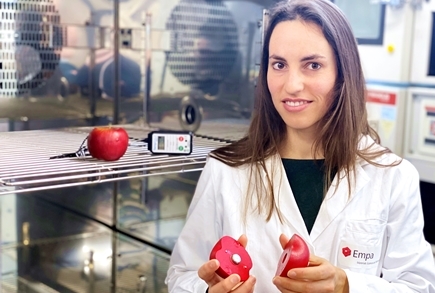A digital twin for citrus fruits
Avatar against food waste
Around one third of all food worldwide ends up in the trash bin instead of on our plate. With the help of digital twins, researchers at Empa and Stellenbosch University are now aiming to reduce food waste, for example in the case of citrus fruits, along the production and supply chains. The hygrothermal measurement data needed to improve the shelf life of oranges and the like would actually be available. So far, however, they have been underutilized, the researchers write in a recent study in the journal Nature Food.

On the way from the place of production to the consumer's plate, about one third of all food worldwide spoils. One reason is unfavorable storage conditions along production and supply chains, including suboptimal storage at home. Researchers at Empa's Biomimetical Membranes and Textiles laboratory in St. Gallen have been working for some time on digital solutions that could reduce this food waste. Now, together with researchers from the University of Bern and South Africa's Stellenbosch University, the team has developed digital twins of citrus fruits and published the results in the journal Nature Food.
Plate instead of trash bin

The 17 Sustainable Development Goals of the United Nations' 2030 Agenda include food security and sustainable agriculture. The Food and Agriculture Organization (FAO) also sees sustainable digital solutions and innovations as a means of achieving these goals. The team led by Chandrima Shrivastava and Thijs Defraeye is now relying on digital information for the virtual doppelgangers of citrus fruits, which they were able to determine by "upcycling," i.e., upgrading data that was hardly used. "Every container in the world is now equipped with one or more temperature sensors," explains Empa's Defraeye. Until now, however, the diverse information hidden in these measurement data has not yet been exploited.
By mathematically evaluating the physical processes, the team was able to use the data sets to track crucial properties of the fruit over time, thereby revealing and even predicting quality losses and marketing problems. To do this, the researchers tracked the temperature development in 47 container loads of citrus fruits over the entire transport route and used computer simulations to determine the probability of corresponding damage, such as decay, moisture loss, cold damage, mold or desirable changes like mortality of fruit fly larvae, in the digital twins.
The result was a wide range of transport conditions and corresponding quality losses. "In our study, half of all shipments were outside the optimal conditions for transport," Defraeye says. The consequences: decay, cold damage, spoiled goods. At the end of their 30-day journey, some of the remaining citrus fruits had a shelf life of only a few days.
Optimum conditions
The solution to the problem, however, is not simply to refrigerate the food. Rather, a precise adjustment of the transport conditions in the form of a compromise is necessary. If, for example, the lemon travels too cool, pests such as fruit flies or other quality impairments are kept at bay. On the other hand, the fruit is damaged by the cold, which may make it unsalable.
Using digital twins, the team has now been able to determine optimal conditions in which relevant risks such as fly infestation, visual defects and cold damage are weighed against each other. Further developments are still needed before the technology can be applied, but the goal is clear: Along their production and supply chains, companies should be able to integrate the virtual fruits into their processes in order to optimize storage conditions in reality and reduce food losses.
Fruit spies on the move

Empa researchers are also working on biophysical twins of fruits and vegetables to reduce food waste. Here, the properties of the crops are perfectly simulated by polymer models. In addition, the biophysical twins are equipped with sensors that measure the temperature and moisture content as they exist on the skin and in the flesh of the real food. In this way, the "spy" among the products reports precise data to optimize conditions during storage and transport – unlike conventional measuring methods.
Most recently, the researchers have expanded the range of existing sensor fruits, apple and mango, to include potatoes and avocados in various sizes, as well as improving materials and the manufacturing process.

Prof. Dr. Thijs Defraeye
Biomimetic Membranes and Textiles
Phone: +41 58 765 47 90
C Shrivastava, T Berry, P Cronje, S Schudel and T Defraeye; Digital twins enable the quantification of the trade-offs in maintaining citrus quality and marketability in the refrigerated supply chain; Nature Food (2022); DOI: 10.1038/s43016-022-00497-9
L You, S Schudel, T Defraeye; Developing of biophysical food for monitoring postharvest supply chains for avocado and potato and deploying of biophysical apple. engrXiv (2022); preprint, DOI: 10.31224/2292
| Audio |

Radio program on Deutschlandfunk, Forschung aktuell, of June 28, 2022, in German
-
Share






